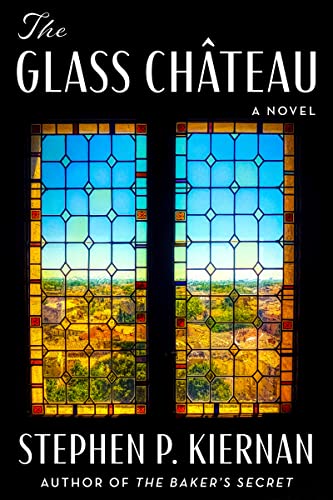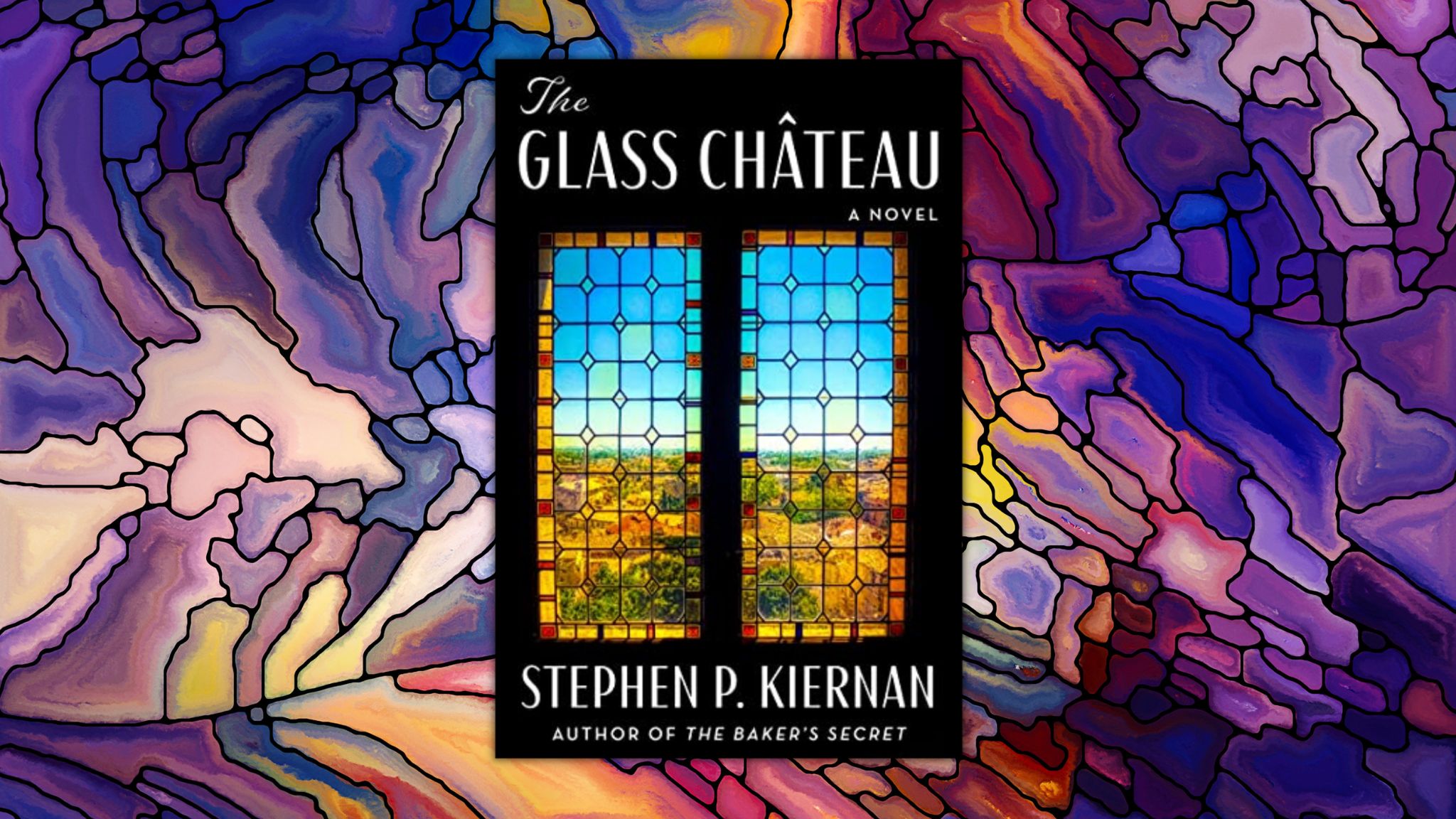The Glass Chateau by Stephen P. Kiernan
What's It About?
A haunting, unforgettable work of post WWII historical fiction.Stephen P. Kiernan was inspired by the stained glass works of Marc Chagall to write The Glass Chateau, a haunting, unforgettable work of post WWII historical fiction. Chagall was born Moishe Shagal in 1887 near Vitebsk, Belarus, then a part of the Russian Empire. This thriving Jewish community endured 19th century pogroms but only 118 from a population of 240,000 survived the Holocaust. For emphasis, the Nazis also leveled the town at the same time.
The artist was one of about 2000 who were rescued through the joint efforts of American journalist Varian Fry and the Marseille-based American Vice-Consul Hiram Bingham who provided expertly forged visas for the USA to prominent artists and intellectuals. Chagall and his wife Bella had been stripped of their French citizenship, labeled undesirables and in May, 1941 narrowly escaped deportation to a concentration camp as a result of this elaborate ruse.
His paintings and prints are infused with vivid colors, light and images of Russian Jewish Folklife including floating figures and fiddlers on rooftops. The works are a striking combination of unconventional designs incorporating surrealistic modernism, symbolism, fauvism and cubism.
Initially, his work was celebrated throughout Europe but in 1937, through a committee directed by Nazi Reich Minister of Propaganda Joseph Goebbels, his museum pieces along with over 20,000 works by other artists were labeled “degenerate,” removed from display and confiscated without compensation to the museums. Approximately one-third of these seized artworks were sold to benefit the Nazi regime beginning in 1939 with a major auction held in Switzerland; about 5000 pieces were burned and the balance disappeared into private hands with some reappearing in worldwide museums.
The multi-faceted Chagall also designed theatrical sets, ceramics, sculptures, murals, mosaics and tapestries. He was nearly 70 when he designed his first stained glass for a church in Assy, France followed by an extended period of designing and creating windows for the Cathedral in Metz. He continued to work in stained glass until his late 80s, dying in France at the age of 97. The genius of his commissioned stained glass works can be found in churches, synagogues, at the United Nations and other sites throughout the world and are now readily available for viewing online.
HAUNTING, UNFORGETTABLE
The Glass Chateau’s protagonist and narrator Asher is a tormented soul who has lost everything that mattered to him including his faith and trust in his fellow man. Before the war he was a happily married man and father of a young daughter whose close-knit extended family resided in the same town; a respected craftsman and established cobbler with a good trade and a reputation for making finely crafted stylish shoes as well as sturdy, waterproof work boots. He attended the synagogue on Holy Days and observed the Sabbath. Fewer French Jews were deported than from other European countries but about 77,000 or one-quarter of the country’s Jewish population were killed by the Nazis, predominantly in “resettlement” concentration camps.
Asher was at work the day his town was taken over by these German invaders and had assumed his wife and child were safely at home and certainly not in the market square. He witnessed Nazi officers commence a killing spree and fire the shots that murdered them both. Vowing to avenge their deaths he immediately joined the resistance. He became a trained assassin; an icy killing machine, directly responsible for the deaths of 19 Nazi occupiers. He felt remorse for and was haunted by the death of one young German corporal who, at the last minute, was commanded to drive the three officers who had murdered his family. Asher had already rigged and set the bomb that exploded when the vehicle started and could do nothing to save the lad.
The Glass Chateau begins one month after the end of WWII. The jubilation lasted a day or two before sobering reality set in as the daunting work of recovery began. Cities, entire towns and villages were heavily damaged and some totally annihilated. Resistance fighters and Jews straggled out of hiding entering the now devastated communities to find their homes gone or usurped, family members dead, tremendous food shortages, sometimes violent interactions and zero relief services. Some of these brave individuals managed to barter their labor or steal food to survive; others among their number starved. Contrary to the Geneva Convention, German POWs and collaborators were all too frequently shot.
No vestiges of Asher’s home remained. His faint hope of seeking refuge in his cobbler’s workshop was dashed when he found it torn asunder and all of his tools and materials stolen. He went back on the road in search of a meal in exchange for work. After several days of fruitless wandering, what later seemed a miracle occurred. He entered a village and stumbled upon Le Chateau Guerin, The Glass Chateau. It was a 450-year-old family-owned and operated atelier of glass designers and glassblowers who made and repaired the stained glass for the churches and cathedrals of France. Using the same painstaking methods, they were ready to resume the process of turning sand into stained glass to restore these holy places.
Marc, the master designer and proprietor of Le Chateau Guerin and his wife Brigitte had also experienced losses of family and craftsman during the long war years. These devout Catholics have taken in a group of emotionally wounded souls, ravaged by the effects of the war, to train to be skilled glass workers. Several grapple with crippling guilt for their wartime actions and all had been homeless and facing hopelessness until the atelier offered food and shelter.
They all harbor secrets including their surnames which they do not reveal. One man is so crushed by his past that he is simply called the “nameless man”. In exchange for hard, exacting work, they received bed with board and gradual training in crafting stained glass windows. The art of creating stained glass for houses of worship, including synagogues, has been practiced for over one thousand years.
The glass is colored by the addition of metallic salts during the glassblowing manufacturing process. Varying sizes of the finished glass are then arranged in patterns according to the design, held together by strips of lead and supported by a frame. It is a balance between artistry and engineering to assemble and snugly install a window capable of withstanding the elements and able to support its own weight while illuminating the interior and inspiring the congregants with the light of the Almighty.
REALISTIC, BELIEVABLE, RICHLY NUANCED
When Asher arrives, his nerves are frayed and he is ready to kill or be killed. Anxious about working among pious Catholics on what is destined to be religious art and sensing some might consider his endeavors sacrilegious, he hides the fact that he is Jewish. His first task requires no skill. It is to speedily bring the workers one of the two types of wood needed to maintain the proper heat in the furnace. For this he earns a bed and a meal. He soon expedites the process by dividing the two woods used into neatly separated piles of like sizes to speed delivery, also demonstrating his usefulness and organizational skills.
Over time, Asher becomes interested in learning more and discovers he has an innate talent for working with glass and creating designs. He willingly works alone to create a light table to illuminate works in progress from underneath and with the support of the owner Marc introduces other innovations. Asher becomes a master of creating windows of great beauty infused with color and light.
He meets Marie, a widow who lost her husband and infant in the war and has assumed responsibility for their family farm which supplies vegetables and flowers to the Chateau, church and village. Initially, the men heckle one another and only grudgingly work together but the calming nature of the purpose of the work begins to prevail bringing a semblance of peace. There are numerous challenges and hurdles to overcome for all of the characters in The Glass Chateau.
Award-winning journalist and lauded fiction writer Stephen P. Kiernan has brilliantly captured the uncertainty of the harrowing, depressing times that followed the end of WWII. He has written a realistic, believable and richly nuanced story of several characters that survived several years of harsh brutality and slowly through a shared purpose begin to regain strength to continue to live and indeed thrive. The compelling character Asher is an inspired homage to artist Marc Chagall. The Glass Chateau is an intelligent, beautifully crafted work of fiction that would be an excellent selection for book clubs. In the hands of a director the caliber of a Stephen Spielberg or Ron Howard, it would be a superb movie.
About Stephen P. Kiernan:
Stephen P. Kiernan has won numerous awards, including the Brechner Center’s Freedom of Information Award, the Scripps Howard Award for Distinguished Service to the First Amendment, and the George Polk Award. He is the author of two previous novels, The Curiosity and The Hummingbird, and two nonfiction books. He lives in Vermont with his two sons.






